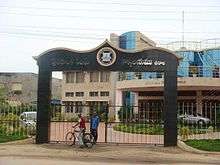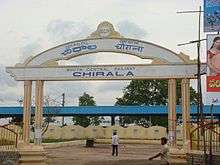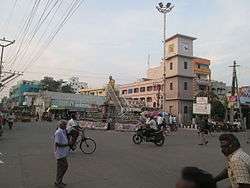Chirala
| Chirala చీరాల Kshirapuri | |
|---|---|
| Town | |
|
Clock Tower Centre in Chirala | |
 Chirala Location in Andhra Pradesh, India | |
| Coordinates: 15°49′29″N 80°21′08″E / 15.8246°N 80.3521°ECoordinates: 15°49′29″N 80°21′08″E / 15.8246°N 80.3521°E | |
| Country | India |
| State | Andhra Pradesh |
| District | Prakasam |
| Government | |
| • Type | Municipal council |
| • Body | Chirala Municipality |
| Area[1] | |
| • Total | 13.30 km2 (5.14 sq mi) |
| Elevation[2] | 3 m (10 ft) |
| Population (2011)[3] | |
| • Total | 87,200 |
| • Density | 6,600/km2 (17,000/sq mi) |
| Languages | |
| • Official | Telugu (తెలుగు) |
| Time zone | IST (UTC+5:30) |
| PIN | 523 155 |
| Telephone code | +91–8594 |
| Vehicle registration | AP-27 |
| Website | Chirala Municipality |
Chirala (![]() pronunciation ) is a town in Prakasam district of the Indian state of Andhra Pradesh. It is a municipality and also the headquarters of Chirala mandal of Ongole revenue division.[4][5] As of 2011 the town had a population of 87,200 and an urban agglomeration population of 162,471.[3][6]
pronunciation ) is a town in Prakasam district of the Indian state of Andhra Pradesh. It is a municipality and also the headquarters of Chirala mandal of Ongole revenue division.[4][5] As of 2011 the town had a population of 87,200 and an urban agglomeration population of 162,471.[3][6]
Etymology
The town was also known as Kshirapuri, which translates as the sea looks as white as milk. The name of the town has got transformed to Chirala. Chira in the regional language means Sari.[7]
History
Chirala, which has earned a unique place in the history of the freedom struggle, which completed its 400 years on April 27, 2004, corresponding with the Telugu calendar `Vaishakha Shuddha Saptami. The foundation for present-day Chirala was laid in 1604 AD by two Yadavas, Minchala Papayya and Minchala Perayya. The town was carved out of Sudhaanagaram, original name of Paata Chirala (Old Chirla), that was granted to Chirala Anantaraju by Goparaju Ramanna, Minister of the Kakatiya king, Ganapati Deva, during Saka 1067 (1145 AD) as mentioned in the records obtained from the Madras Oriental Library. His descendant, Chirala Venkata Krishnudu, leased out the present Chirala area to the Yadavas for raising a new township. Thus, present-day Chirala was born on Vaishakha Shuddha Saptami of Vishwavasu Vatsaram or Vishwavasu Samvatsaram (Year name as per Telugu calendar), corresponding to 1604 AD.
In the new township, a Venugopalaswamy temple was constructed in 1619 and that of Malleswaraswamy in 1620, while that of Gangamma was built a little later. As the temples did not have any chariots, Chirala Ramanna Pantulu built two chariots for the two temples towards the middle of the 19th century. Now a lot of temples have come up.
With the advent of a railway station on the Madras-Calcutta-New Delhi main line, Chirala developed commercially with its population reaching a little over two lakhs and fifty thousands, while Paata Chirala, which once traded through the ancient port of Motupalli, shrunk to become an obscure village with a population of just 5,000.
Anuguraju of the Hyheya dynasty, who ruled over Palanadu, visited Paata Chirala along with his entourage that included the famous socio-religious reformer, Brahma Naidu, during the twelfth century and left behind the idol of Chennakeshava Swamy, his family deity with his consorts and weapons, used by Palanadu warriors. The ancient Aadikeshava Swamy temple, originally built by the Cholas during the eleventh century, and now in a dilapidated condition, is being rebuilt by Shri Arulananda Swamy, head of Shri Lalitaananda Ashram of Oodarevu, near here.
Chirala, which was regarded as a health resort by Britishers, got a medical facility as early as in 1906 with the opening of the Edward VII Coronation Memorial Hospital. Dr. Mary Baer, an American, also opened the Dr. Baer Missionary Hospital in 1912 when Chirala and its neighborhood villages did not have medical facilities except at Guntur.
This town was a stage for the well known Chirala – Perala movement, which was led by Andhra Ratna Duggirala Gopalakrishnayya garu. He has fought against British municipalities which levied higher taxation on the people.
The Europeans also started a tobacco curing factory of the ITC Limited in 1923, opening job opportunities to people.
Geography
The coordinates of the town are 15°49′29″N 80°21′08″E / 15.8246°N 80.3521°E and is located at an altitude of 3 m (9.8 ft) from the coast of Bay of Bengal.[2]
Climate
The town experiences tropical climate with the average annual temperature records at 28.5 °C (83.3 °F). Hot summers and cool winters are observed due to its proximity to the coast of Bay of Bengal. It receives both South west monsoon and North-east monsoon as well. The precipitation is very high with an annual rainfall of about 200 millimetres (8 in) and the month of October receives a maximum rainfall of 197 millimetres (8 in).[8]
Governance

Civic administration
Chirala Municipality oversees the civic needs of the town
like, water supply, sewage, garbage collection etc. The municipality was established on 1 April 1948 and is a I–Grade municipality. It is spread over an extent of 13.30 km2 (5.14 sq mi) with 33 wards.[1][9]
Economy
Handloom weaving industry is one of the main occupation of the town.[10]
Demographics
As of 2011 census of India, the town had a population of 87,200 with 23,070 households. It shows 2.04% growth in population, compared to 2001 Census of India which was recorded as 85,455.[11] The total population constitute, 42,927 males and 44,273 females —a sex ratio of 1031 females per 1000 males, higher than the national average of 940 per 1000.[12] 8,389 children are in the age group of 0–6 years, of which 4,253 are boys and 4,136 are girls —a ratio of 973 girls per 1000 boys. The average literacy rate stands at 78.80% with 62,099 literates, higher than the national average of 73.00%.[4][13]
Transport

The town is also well connected with National and state highways. The National Highway 214A passes through the town, which connects Digamarru and Ongole.[14] State Highway 48, also referred as Guntur-Bapatla-Chirala Road connects the town with Guntur.[15] State Highway 45 connects it with Piduguralla, which passes through Narasaraopet and Chilakaluripet.[16] Public transport includes, the buses operated by state run APSRTC services. Chirala railway station is an A–Category station in Vijayawada Railway Division of South Central Railway zone. It is located on the Howrah-Chennai main line of Indian Railways.[17]
Education
The primary and secondary school education is imparted by government, aided and private schools, under the School Education Department of the state.[18][19] The medium of instruction followed by different schools are English, Telugu.
See also
References
- 1 2 "Municipalities, Municipal Corporations & UDAs" (PDF). Directorate of Town and Country Planning. Government of Andhra Pradesh. Archived from the original (PDF) on 28 January 2016. Retrieved 29 January 2016.
- 1 2 "Maps, Weather, and Airports for Chirala, India". fallingrain.com.
- 1 2 "Census 2011". The Registrar General & Census Commissioner, India. Retrieved 25 July 2014.
- 1 2 "District Census Handbook – Prakasam" (PDF). Census of India. p. 16–17,44. Retrieved 18 January 2015.
- ↑ "Guntur District Mandals" (PDF). Census of India. pp. 141,175. Retrieved 19 January 2015.
- ↑ "Agglomerations & Cities". Citypopulation.de. Retrieved 18 September 2015.
- ↑ "Chiral". apcofabrics.com. Retrieved 2 March 2016.
- ↑ "CLIMATE: CHIRALA". Retrieved 29 February 2016.
- ↑ "Basic Information of Municipality". Commissioner & Director of Municipal Administration. Municipal Administration & Urban Development Department, Govt. of Andhra Pradesh. Retrieved 6 August 2014.
- ↑ Murali, S (14 October 2015). "Chirala weavers upbeat over heavy procurement orders". The Hindu. Chirala. Retrieved 2 March 2016.
- ↑ "Census of India 2001: Data from the 2001 Census, including cities, villages and towns (Provisional)". Census Commission of India. Archived from the original on 2004-06-16. Retrieved 2008-11-01.
- ↑ "Sex Ratio". The Registrar General & Census Commissioner, India. Retrieved 29 August 2014.
- ↑ "Chapter–3 (Literates and Literacy rate)" (PDF). Registrar General and Census Commissioner of India. Retrieved 29 August 2014.
- ↑ "National Highways in A.P". AP Online Portal. Retrieved 4 August 2014.
- ↑ Samuel Jonathan, P (8 October 2015). "Nizampatnam backwaters beckon adventure geeks". The Hindu. Guntur. Retrieved 29 February 2016.
- ↑ "Road Maps". Roads and Buildings Department. Government of Andhra Pradesh. Retrieved 29 February 2016.
- ↑ "Vijayawada division – A Profile" (PDF). South Central Railway. Archived from the original (PDF) on 28 January 2016. Retrieved 29 February 2016.
- ↑ "School Eduvation Department" (PDF). School Education Department, Government of Andhra Pradesh. Retrieved 7 November 2016.
- ↑ "The Department of School Education - Official AP State Government Portal | AP State Portal". www.ap.gov.in. Retrieved 7 November 2016.
External links
| Wikimedia Commons has media related to Chirala. |
